
Aluminium is a chemical element; it has symbol Al and atomic number 13. Aluminium has a density lower than that of other common metals, about one-third that of steel. It has a great affinity towards oxygen, forming a protective layer of oxide on the surface when exposed to air. Aluminium visually resembles silver, both in its color and in its great ability to reflect light. It is soft, nonmagnetic, and ductile. It has one stable isotope, 27Al, which is highly abundant, making aluminium the twelfth-most common element in the universe. The radioactivity of 26Al leads to it being used in radiometric dating.
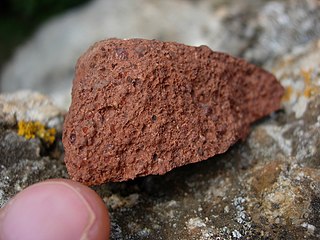
Bauxite is a sedimentary rock with a relatively high aluminium content. It is the world's main source of aluminium and gallium. Bauxite consists mostly of the aluminium minerals gibbsite, boehmite and diaspore, mixed with the two iron oxides goethite and haematite, the aluminium clay mineral kaolinite and small amounts of anatase and ilmenite . Bauxite appears dull in luster and is reddish-brown, white, or tan.

Glycine is an amino acid that has a single hydrogen atom as its side chain. It is the simplest stable amino acid. Glycine is one of the proteinogenic amino acids. It is encoded by all the codons starting with GG. Glycine is integral to the formation of alpha-helices in secondary protein structure due to the "flexibility" caused by such a small R group. Glycine is also an inhibitory neurotransmitter – interference with its release within the spinal cord can cause spastic paralysis due to uninhibited muscle contraction.
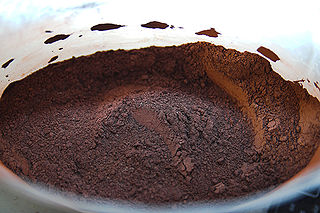
Thermite is a pyrotechnic composition of metal powder and metal oxide. When ignited by heat or chemical reaction, thermite undergoes an exothermic reduction-oxidation (redox) reaction. Most varieties are not explosive, but can create brief bursts of heat and high temperature in a small area. Its form of action is similar to that of other fuel-oxidizer mixtures, such as black powder.
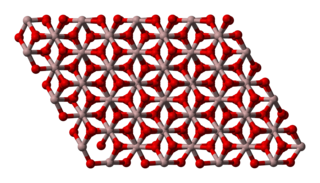
Aluminium oxide (or aluminium(III) oxide) is a chemical compound of aluminium and oxygen with the chemical formula Al2O3. It is the most commonly occurring of several aluminium oxides, and specifically identified as aluminium oxide. It is commonly called alumina and may also be called aloxide, aloxite, or alundum in various forms and applications. It occurs naturally in its crystalline polymorphic phase α-Al2O3 as the mineral corundum, varieties of which form the precious gemstones ruby and sapphire. Al2O3 is used to produce aluminium metal, as an abrasive owing to its hardness, and as a refractory material owing to its high melting point.

Aluminium foil is aluminium prepared in thin metal leaves. The foil is pliable and can be readily bent or wrapped around objects. Thin foils are fragile and are sometimes laminated with other materials such as plastics or paper to make them stronger and more useful.
ATC code A02Drugs for acid related disorders is a therapeutic subgroup of the Anatomical Therapeutic Chemical Classification System, a system of alphanumeric codes developed by the World Health Organization (WHO) for the classification of drugs and other medical products. Subgroup A02 is part of the anatomical group A Alimentary tract and metabolism.

Aluminium chloride, also known as aluminium trichloride, is an inorganic compound with the formula AlCl3. It forms a hexahydrate with the formula [Al(H2O)6]Cl3, containing six water molecules of hydration. Both the anhydrous form and the hexahydrate are colourless crystals, but samples are often contaminated with iron(III) chloride, giving them a yellow colour.
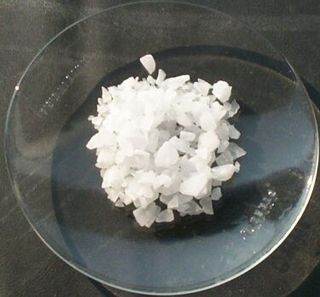
Aluminium sulfate is a salt with the formula Al2(SO4)3. It is soluble in water and is mainly used as a coagulating agent in the purification of drinking water and wastewater treatment plants, and also in paper manufacturing.

The Bingel reaction in fullerene chemistry is a fullerene cyclopropanation reaction to a methanofullerene first discovered by C. Bingel in 1993 with the bromo derivative of diethyl malonate in the presence of a base such as sodium hydride or DBU. The preferred double bonds for this reaction on the fullerene surface are the shorter bonds at the junctions of two hexagons and the driving force is relief of steric strain.

Thiamphenicol is an antibiotic. It is the methyl-sulfonyl analogue of chloramphenicol and has a similar spectrum of activity, but is 2.5 to 5 times as potent. Like chloramphenicol, it is insoluble in water, but highly soluble in lipids. It is used in many countries as a veterinary antibiotic, but is available in China, Morocco and Italy for use in humans. Its main advantage over chloramphenicol is that it has never been associated with aplastic anaemia.

An aluminium alloy (UK/IUPAC) or aluminum alloy is an alloy in which aluminium (Al) is the predominant metal. The typical alloying elements are copper, magnesium, manganese, silicon, tin, nickel and zinc. There are two principal classifications, namely casting alloys and wrought alloys, both of which are further subdivided into the categories heat-treatable and non-heat-treatable. About 85% of aluminium is used for wrought products, for example rolled plate, foils and extrusions. Cast aluminium alloys yield cost-effective products due to the low melting point, although they generally have lower tensile strengths than wrought alloys. The most important cast aluminium alloy system is Al–Si, where the high levels of silicon (4–13%) contribute to give good casting characteristics. Aluminium alloys are widely used in engineering structures and components where light weight or corrosion resistance is required.

Magnesium gluconate is a compound with formula MgC12H22O14. It is the magnesium salt of gluconic acid.

Aluminium Arak Football Club, commonly known as Aluminium Arak, is an Iranian football club based in Arak, Markazi, that competes in the Persian Gulf Pro League. The club was founded as PAS Arak Football Club in 2001. The club is part of Aluminium Arak Sport and Cultural Club.

Magnesium malate, the magnesium salt of malic acid, is a mineral supplement often used for nutritional concerns. It is represented by the chemical formula C4H4MgO5 and has a molecular weight of 156.376 g/mol. Magnesium malate is discussed as being a more bioavailable form of magnesium, along with other forms such as citrate and glycinate.
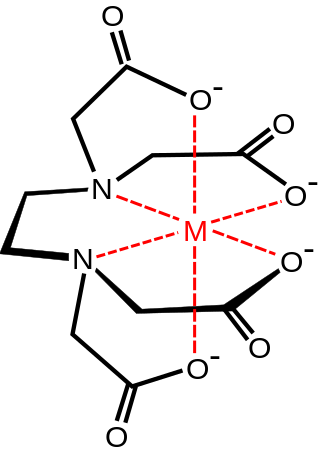
An aminopolycarboxylic acid is a chemical compound containing one or more nitrogen atoms connected through carbon atoms to two or more carboxyl groups. Aminopolycarboxylates that have lost acidic protons form strong complexes with metal ions. This property makes aminopolycarboxylic acids useful complexone in a wide variety of chemical, medical, and environmental applications.
Magnesium salts are available as a medication in a number of formulations. They are used to treat magnesium deficiency, low blood magnesium, eclampsia, and several other conditions. Magnesium is an essential nutrient.
Magnesium glycinate, also known as magnesium diglycinate or magnesium bisglycinate, is the magnesium salt of glycine, and is sold as a dietary supplement. It contains 14.1% elemental magnesium by mass.
Transition metal amino acid complexes are a large family of coordination complexes containing the conjugate bases of the amino acids, the 2-aminocarboxylates. Amino acids are prevalent in nature, and all of them function as ligands toward the transition metals. Not included in this article are complexes of the amides and ester derivatives of amino acids. Also excluded are the polyamino acids including the chelating agents EDTA and NTA.

Copper(II) glycinate (IUPAC suggested name: bis(glycinato)copper(II)) refers to the coordination complex of copper(II) with two equivalents of glycinate, with the formula [Cu(glycinate)2(H2O)x] where x = 1 (monohydrate) or 0 (anhydrous form). The complex was first reported in 1841, and its chemistry has been revisited many times, particularly in relation to the isomerisation reaction between the cis and trans forms which was first reported in 1890.

















